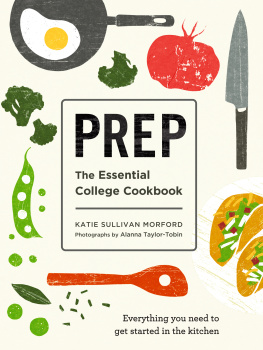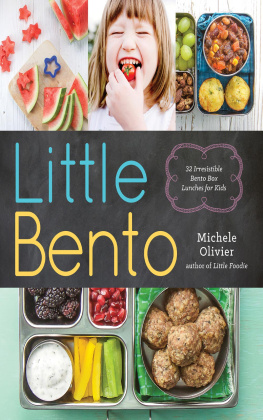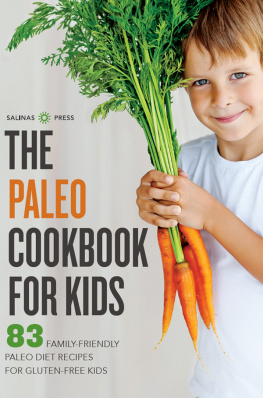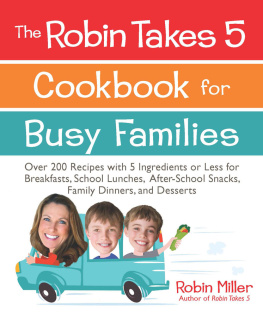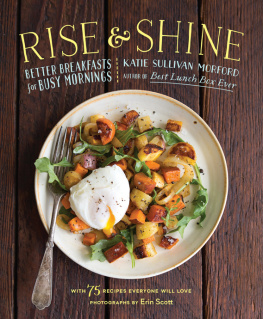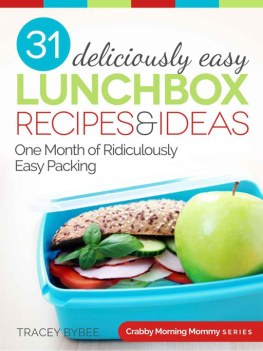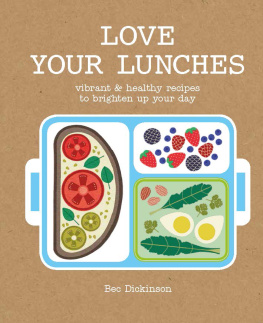
For my girls
Text copyright 2013 by Katie Sullivan Morford.
Photographs copyright Chronicle Books LLC.
All rights reserved. No part of this book may be reproduced in any form without written permission from the publisher.
ISBN 978-1-4521-3903-6
The Library of Congress has previously cataloged this under:
ISBN 978-1-4521-0829-2
Designed by Eight Hour Day
Photographs by Jennifer Martin
Food styling Karen Shinto
Prop styling by Leigh Noe
Chronicle Books LLC
680 Second Street
San Francisco, California 94107
www.chroniclebooks.com
Introduction
Why a Lunch-Box Book?
My friend Pam, a mother of two, can practically turn out a dozen golden popovers with her eyes shut. Claire, also a mom, tackles even the most sophisticated recipes with the ease of a professional. And Suzanne churns out family dinners each night in such an orderly fashion, she could teach Martha Stewart a thing or two. But ask any of these bercapable momsor dads, grandparents, or other caregivers, for that matterhow they feel about packing school lunches every day and you are likely to hear a groan, a sigh, or, quite possibly, a growl.
WHAT GIVES?
First off, packing lunch is a relatively thankless task; we arent even around when the kids crack those containers open. Plus, filling a lunch box is booby-trapped with challenges: keeping some foods hot and others cold, preventing sandwiches from going mushy and fruit from bruising, figuring out what kids will like (and eat!), and doing it all in the few extra minutes of the day you really dont have. And thats not even taking into account the folks who have to work around a kids food allergy or a ten-year-old whos suddenly gone vegan. Phew! Its a lot to cover. With three daughters of my own, Ive packed roughly 4,000 lunches and counting. Its not easy, but Ive learned a thing or two along the way.
This book brings together my expertise as a registered dietitian, food writer, and cooking teacher with my hands-on experience as a parent. My aim is to arm you with easy recipes and practical advice for lunches your kids will actually eat instead of toss in the trash.
All of the recipes are based on how we do things around our house. Good ingredients and simple preparation are the foundations of my cooking, with an eye to nourishing kids, not just filling them up. I rely largely on seasonal organic produce; sustainably raised eggs, dairy, fish, poultry, and meat; and whole grains. Convenience foods such as jarred applesauce and prepared soups fill in as needed. While Im not churning butter from my own grass-fed dairy cows, Im also not buying fried snack foods in bulk. Its a balancing act.
This book is a toolbox full of fresh ideas to help you break from the lunch-box rut that plagues the best of us. Most of the recipes are quite flexible, intended for tinkering to suit your familys preferences and whatever happens to be in your pantry. Capers too fancy? Use chopped relish. Tofu too health foodie? Substitute chicken. Chocolate chips not health foodie enough? Leave em out. Your child, your cooking, your lunches.
My hope is that this book is approachable. When its not, please tailor the recipes to suit you. Whether your offspring is four or fourteen, the idea is that the Best Lunch Box Ever should inspire you so that making lunches can be a little more joyful and less of a chore.
CHAPTER 1
Brown Bag Basics
WEEKDAY MORNINGS CAN BE DOWNRIGHT NUTTY. On some days, the fact that you manage to pull a lunch together at all feels like a minor miracle, never mind if it has much in the way of nutritional value. And what does a nourishing lunch really look like anyway?
This chapter is intended to help you understand just that. Through practical nutrition advice and food safety tips, packing healthful lunches can become second nature, even in the chaotic rush of school-day mornings. Ive included a comparison of traditional school lunches with new and improved versions to illustrate how little changes in ingredients can make a big difference in nutrients . Perhaps this will encourage you to make a few tweaks in your kitchen that result in more wholesome packed lunches.

BROWN BAG BASICS
Know Good Nutrition
Theres no getting around the fact that pulling together a healthful school lunch is a worthy pursuit. What children eat during the school day puts a significant dent toward meeting their dietary needs, so you gotta make it count. While a bag of cheese puffs, can of soda, and salami on white might fill them up, its not truly nourishing them. You can deliver those same calories with a lot more nutrition, which todays kids definitely need. Consider this: According to the USDA, the diets of more than 80 percent of kids between the ages of two and nine need substantial improvement. Yikes!
Heres what a nutritious, well-thought-out school lunch can do for kids:
Fuel their brains so they can focus in class.
Support growth and development.
Promote healthful eating habits.
Energize them to participate to their fullest in everything from physics to phys ed.
Provide fiber, vitamins, minerals, and other key nutrients.
Help them maintain an appropriate weight.
Offset moodiness.
Let them know how much you care, especially if you include a loving note or other thoughtful gesture.
So what really needs to be packed in that lunch box to ensure its well balanced?
Start by emphasizing fresh, seasonal, whole food that has spent more time on a farm than in a manufacturing plant. Cobbling together a nutritious lunch gets a lot easier if you rely on real food from the get-go. It neednt be complicated or scientific. Heres the lowdown on the building blocks of a healthful midday meal.
WHOLE-GRAIN FOODS
Whether its the whole-wheat bread on a sandwich or the brown rice in a stir-fry, whole grains are the core of a solid school lunch. These complex carbs provide the quickest form of energy and are the number-one fuel for those hardworking brains. Whole grains take longer to digest than processed ones, supplying your child with a steady source of energy.
Using whole grains is key since they havent been stripped of the bran and germ (and the nutrients that go along with them). Dont be duped by deceptive marketing. Many foods made from grains, breads in particular, get paraded around as if they are more healthful than they are. Read the label and look for the word whole as in whole wheat instead of just wheat.
Grocery and specialty stores now stock an array of grains from which to choose: barley, farro, quinoa, oats, bulgur wheat, brown rice, spelt, amaranth, teff, buckwheat, and millet. You can also buy a huge variety of whole-grain pastas and breads. And get this: Popcorn is a whole grain, too. How cool is that?
PROTEIN FOODS
Its essential to balance grains with protein-rich foods, which provide important nutrients and help to keep blood sugar steady so your child doesnt bottom out in class. Protein also stimulates brain activity, promoting the alertness necessary for a successful school day.
The likes of meat and chicken usually come to mind when we think of protein, but plant-based foods shouldnt be overlooked. Choosing, say, black beans over ground beef for example, costs less, and theyre lower in unhealthful fats. Plus, theyre gentler to the environment since growing beans produces less greenhouse gases than raising and processing meat.
Next page

